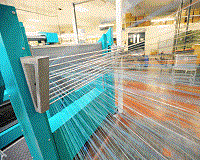"In order to assess the overall financial performance of Indian textile sector on a continuous basis, Wazir Advisors has developed the Wazir Textile Index (WTI). This index gives the collective performance of select top 10 listed textile companies (by sales) of 2015-16 as the base/benchmark, represented by the base Index number 100. The base is taken for each quarters and full financial year performance of the companies in 2015-16. "

In order to assess the overall financial performance of Indian textile sector on a continuous basis, Wazir Advisors has developed the Wazir Textile Index (WTI). This index gives the collective performance of select top 10 listed textile companies (by sales) of 2015-16 as the base/benchmark, represented by the base Index number 100. The base is taken for each quarters and full financial year performance of the companies in 2015-16. Financial performance of the textile industry will be benchmarked on this base number to assess quarterly (Q1), half yearly (H1), nine monthly (9M) and yearly performance (FY) for future years against the set benchmark. WTI includes the following three components: WTI Sales, WTI EBITDA, and WTI Cost.
Marginal improvement

As per latest WTI, India’s real GDP increased from Rs 114 lakh crore to Rs 122 lakh crore, in 2017, with a growth rate of 7.1 per cent. Textiles saw an IIP increase of 1 per cent from 156.4 to 158 while IIP for apparel dipped by 1 per cent from 192 to 189.6 in FY17 compared to FY16. With an increase of 1 per cent, WPI stood at 141.8 in FY17.
Stagnant exports
Textile and apparel exports in FY17 declined at the rate 0.2 per cent from previous year, to reach $36.6 bn. Apparel had majority share in exports valued at $17.4 bn. Exports of filament yarn, apparel and home textile categories registered a growth in FY17. Highest growth was observed in filament yarn exports which grew at 9 per cent from $1.01 bn to $1.11 bn in FY17. However, exports of fibre, spun yarn, fabric et al declined. Highest fall was registered by fibre, a decrease of 8 per cent from $2.7 to 2.5 bn in FY17. Exports of both yarn and fabric categories fell by 5 per cent each in FY17. The US and UAE stood as the largest export markets for India, with a cumulative share of 34 per cent, a 2 per cent rise over last year. Exports to UK and China & Hong Kong decreased 1 per cent in FY17 while exports to Bangladesh remained the same.
Increased imports
Clocking in $6 bn, textile and apparel imports in FY17 increased at 3.1 per cent from previous year. Growth was due to a significant increase in fibre imports by 41 per cent over FY16. However, imports of other major categories like yarn, home textiles & fabric declined at 26 per cent, 23 per cent and 8 per cent respectively. China continued to be India’s largest import partner, however, its share in total imports fell 6 per cent while Australia’s import share increased significantly from 3 to 7 per cent due to an unprecedented 845 per cent growth in cotton fibre imports. Imports from the US also increased at 3 per cent while imports from Vietnam remained the same.
Raw material price hike
On an average, raw cotton and viscose staple fibre prices increased 19 per cent and 7 per cent respectively while polyester staple fibre prices declined by 2 per cent in FY17. There was an increase in cotton yarn and polyester viscose blended yarn average prices growing at 5 per cent and 6 per cent respectively in FY17. However, polyester cotton blended yarn registered a decline of 7 per cent in FY17 compared to FY16.
Following this performance evaluation, it remains to be seen how the industry battles the GST demon












